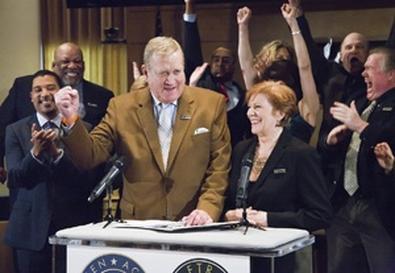
Photo Source: Beth Coller
In an instant last Friday, SAG’s James Cagney Boardroom exploded with applause, joy, gratitude and relief – and became SAG-AFTRA’s James Cagney Boardroom. The vote was resounding: AFTRA members voted 86 percent Yes and SAG members – who had voted down merger twice in the last 13 years – gave a stunning 82 percent thumbs up. The turnout was high as well (52 percent and 53 percent, respectively).
Monday morning brought the reality that even harder work lay ahead. Integrating a 600-person staff is tough. But leave aside cardkeys and org charts. The new union is going to be tested in battle – and sooner than most people realize. Three challenges await:
1. Mobilize the Members
SAG-AFTRA’s 150,000 members make it the largest entertainment union, but that doesn’t mean they’re organized. Much of the last decade and a half has been an inward-looking struggle for the soul of the performers’ unions, which played out as inter-union wars, intra-SAG civil wars, stalled contract talks, repeated litigation (some of which is still pending) and, of course, the three merger referenda.
Now the union’s task is to organize members across the country: to get them to come together with each other – and with members of other entertainment unions – for productive purposes, whether it be networking, education, or just fun and games on weekends. The goal: a network of relationships and solidarity that turns a mass of workers into a potential fighting force. That’s the implicit threat – the big stick – that unions need in order to speak softly but persuasively at the bargaining table.
Not for nothing did SAG-AFTRA co-president Roberta Reardon remark to “The Hollywood Reporter” that “Organizing is the lifeblood of any union and our members know it.”
2. Pick up the Pace on P&H
The “SAG” marketshare of fall series will fall decisively below 50 percent this year and that puts continued pressure on the SAG pension and health plans, which are funded based on earnings under SAG contracts. Yes, it’s all one union now, but the contracts are separate – and so are the corresponding pension and health plans. Consolidating them will take time.
With the SAG health plan cutting benefits and raising premiums at a dramatic rate, and members falling short of earnings qualification levels for coverage under either the SAG or AFTRA plan, the time for action is now. Union officials have proposed reciprocity between the plans as an interim answer. They, and the plans’ trustees, need to move quickly.
3. Control the Contract Negotiations
The big-ticket commercials negotiations start this fall and they'd be difficult under any circumstances because of the growth of non-union work and because the ad industry wants to completely revamp residuals.
But now, the industry will be testing the new union to see what kind of opponent it is. Quick to compromise? Strong in a fight? Ready to strike? Union leaders won’t talk strategy, but executive vice president Ned Vaughn did say “we're going to have to fight hard and smart for every gain we want.”
The choices and outcomes are critical, because they’ll send a signal to entertainment stakeholders too, such as agents, lawyers, other Hollywood unions and – most importantly – the studios and networks, whose negotiations start 12-18 months later.
Leverage is about perception as much as reality, and the commercials negotiation will be the first impression anyone has of what the new SAG-AFTRA union really means. People don't get a second chance to make a first impression. Neither do new unions.
- The Hollywood Reporter